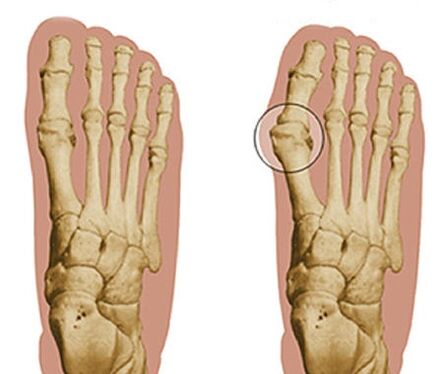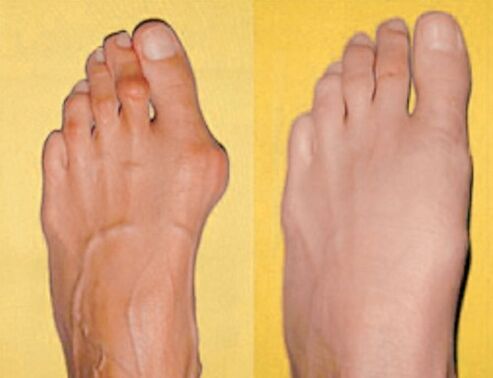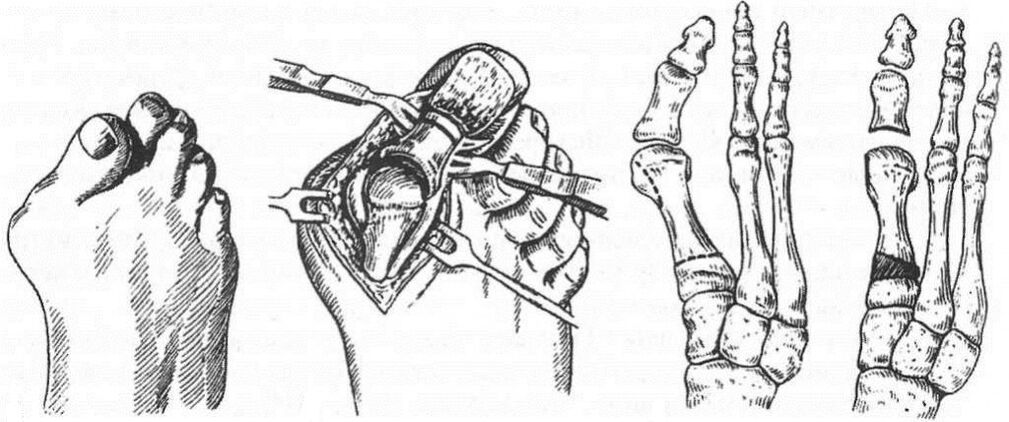Many people live with flat feet without attaching any meaning to it.But in fact, changes in the shape of that part of the body, which is actually its support, are a serious sign that you need to think about your own health and implement some measures to eliminate the problem.
What is it

The deformation of the valgus of the steps is a specific pathology of the lower limb, which consists in violation of the correct functional position.The main signs of this disease are the disturbance of the axis of the foot, as well as a decrease in its height.Due to the pathology, all the elements of the foot take the wrong position.This applies, including heels and phalanges of the fingers.Therefore, the leg itself acquires the appearance of X.
According to the international classification of diseases of the tenth revision, the deformity of the valgus of the steps belongs to the class of the disease of the bone muscle system and connective tissue, the group of arthropathy.
Valgus deformation of the thumb of the foot is a change in the correct position of the phalanx of the first finger, resulting in bending outwards.This is due to the fact that the angle between the first and second metatarsal bones increases.
The patient's initial check with the problems of the deformation of the foot should be performed by a qualified orthopedic traumatologist.In some cases, he may direct the patient to other related specialists in the future, but in general he deals exclusively with the problems of these pathologies.
Reasons
There is a rather extensive list of various reasons why Valgus deformation can occur in an adult.Among them, experts emphasize the most popular options:
- improperly selected shoes or insoles in it (incorrectly selected size or too tight parts of the shoes);
- Long and honor in shoes or high hesitation boots (for some people 4 cm is already quite high);
- some injuries to the foot (including subluxation of the first finger phalanx);
- gout (the disease is accompanied by the accumulation of uric acid in the tissues of the body, leading to their deformities);
- weakening of the tendons (congenital or acquired);
- genetic predisposition;
- Excessive body weight (weight creates an additional stress of the foot);
- hormonal malfunctions (which are often characteristic of menopause in women);
- pregnancy and carrying a child (this process creates a very large load on the human musculoskeletal system);
- Flat legs (different weight and shapes).
Some causes of valgus deformity cannot be eliminated while others are adjusted, so it is always necessary to start treatment with this process.
The reasons for the reasons will be shown in this small video.
Species and degrees
Traumatologists determine many types of valgus deformity in adults, which directly depend on the cause of the disease.The following common forms can be distinguished:
- static;
- compensator;
- paralytic;
- spastically;
- hypercorection;
- Rickets;
- traumatic, etc.

In addition, there are three main degrees of development of valgus deformation of the legs.They all have their distinctive clinical characteristics and individual characteristics, on the basis of which specialists determine them:
- Grade I is characterized by the fact that the joints change in the angle between the metatarsal bones.At the same time, Sesam -shaped ligaments are mobile.Due to such a clinical picture, subluxation of the foot occurs.The finger deviates from the axis to only 15 degrees.
- Grade II is different in that the tendons of the foot continue to be displaced along with the connections of the first thumb.The finger deviates from 15 to 20 degrees.
- III degree of disease leads to the fact that bones and connective tissues begin to be very vulnerable and weak.They stop dealing with the load that is on them.At the same time, the finger deviates to 20-30 degrees from the axis of the foot.
- Grade IV is the last stage of changing the type of legs when the deformation reaches a significant degree, while leading to serious consequences.The finger deviates from the norm at an angle above 30 degrees.
Depending on the degree of development of the disease, appropriate symptoms are manifested.At first, they are insignificant, but over time they begin to carry very serious problems for the sick person.
Symptoms
Symptoms of Valgus deformation of the foot are quite unpleasant, which is due to the fact that a person is constantly experiencing uncomfortable sensations.In addition to them, the pain syndrome may occur.Doctors distinguish the following list of symptoms that characterize the pathology:
- painful sensations when you wear even high quality and seemingly comfortable shoes;
- changing the length of the foot, which leads to difficulty in choosing shoes of the usual size;
- leg pain after and at the end of the day;
- Deformation of the first and second phalanx of the foot;
- the appearance of painful calluses on the first toe of the foot;
- worsening of blood circulation and feeding of the foot;
- The development of arthrosis.
The onset of symptoms of deformity of the legs should lead to attraction of a sick person to a medical institution for qualified help in the form of diagnosis and determination of treatment.
Diagnostics
It is impossible to treat the deformation of the legs with a flat valgus without a proper overall examination of the lower limbs of a person.This will not produce an appropriate result and in some cases can lead to a deterioration in the situation.
The main instrumental diagnostic method used by the orthopedists of the traumatologist is radiography.The patient should make X -ray to stop in three different projections.
Based on radiography, the degree of development of the disease can be determined, as well as related to pathologies, if any.Life can also be recommended by computer plantographic - a diagnostic method that allows you to determine some of the basic parameters of existing deformities of the feet.It is important to exclude cysts, aseptic necrosis, inflammation of the periosteum from complications.Based on the data obtained from the radiographic examination, the orthopedic traumatologist should determine the optimal method of eliminating the problem of deformation of the valgus of the foot in the patient.

Treatment
The first stages of valgus deformation of the feet in adults are well busy with treatment with the help of simple orthopedic agents.First, this applies to orthopedic insoles in the shoes.They adjust the foot by giving it the correct position.They can be used with special leaders.Another addition is special toes concealers, as well as additional foot screeds.It is best to buy individually created shoes for a specific person, which, based on his clinical picture, will adjust the deformation of the foot most properly and correctly.The third degree of deformation of Valgus on the foot is completely impossible to completely adjust without surgery, but using a complete set of methods can achieve a good result.Most often in such cases, special massages and manual therapy are also recommended.The course becomes only ten sessions that should be repeated every few months.
In addition, it must be taken into account:
- Physiotherapy methods are not used to treat valgus deformation of the legs.They minimize the severity of the symptoms.
- In the event of an inflammatory process and syndrome of severe pain, which leads to the inability to walk, the doctor may prescribe anesthetic and anti -inflammatory drugs of a person, both topical use and systemic.
- Surgical intervention to eliminate the deformity of the valgus of the legs is performed in severe cases with prolonged neglect of the disease, which has reached the last degree of development.The operation consists in the installation of the deformed bones on the foot in its proper place and in their fixation there with the help of pins.
- At higher stages, surgeons can conduct a small traumatic intervention that does not mean plaster or metal structures.In this case, the angle between the bones is adjustable only so that the load is properly distributed.Then other methods of therapy will produce the best result.
Home treatment
Often, doctors recommend some gymnastic exercises to their home patients.They can be one of the methods of treatment and a preventative that prevents the disease.
Gymnastics consists of a set of exercises that do not need considerable preparation:
- The patient should lie on his back.He then has to simulate cycling, alternating, pulling the socks of each leg from it and returning his feet to his place.Repeat such actions should be 8-10 times.
- One has to sit on the floor, straighten his feet and rest with his hands behind him.The lower limbs should be bent and exchanged in the ankle area.Repeat such actions on one leg is required 10 times.
- In the previous position, you need to greatly spread your toes in different directions, fixing them in this position for a few seconds.Repeat this exercise needs a standard number of times.
- In a position sitting on the floor with your legs stretched forward, you should pull out and give up your fingers on them.Repeat the exercise should be six times.
- Sitting in a chair, the fingers of the lower limbs must be gradually sorted to make the leg movement on the floor.Repeat such "caterpillars" 8 times.
- Sitting in a chair, holding a pen or pencil between the toes, it is necessary to produce circular movements with it.After a few times it is necessary to change the location of the selected thing to another.
- You need to walk on different parts of the foot - socks, side surfaces and legs.In the first case, the hands should be raised, in the second and third - on the belt.
You can also sometimes walk outside the complex, lifting his knees high, holding his hands in front of you.You can also periodically stretch your legs, thus fragmenting them.You can also perform exercises with this little video.

Adult prevention
First, as a preventative measure for the deformation of the steps, it is necessary to periodically be monitored in an orthopedic traumatologist.This doctor may be suspected of developing the disease and prevent it at an early stage:
- A doctor's visit is a way that suggests the detection of the disease.In order not to develop the disease, it is only necessary to start with high quality and comfortable shoes to start choosing that fit properly under a person's leg structure.It is best to buy boots and shoes without heels and sharp socks by choosing natural materials.
- Orthopedic insoles in shoes can significantly reduce the risk of leg deformation.They must be purchased at a specialized pharmacy or medical institutions.
- Plan for work and work.In particular, we are talking about people who, because of their professional duties, are forced to be on their feet.The lower limbs should rest and relax periodically.
- The constant loading of the lower leg and legs can lead to the development of various diseases of the musculoskeletal system and exacerbate existing diseases.In this article, you can find out how to choose the right orthopedic adult insoles.
In the first manifestations of severe symptoms of leg deformity, it is necessary to contact qualified specialists, as this disease can have serious consequences.If you make a diagnosis on time, the treatment may be less invasive and not so serious, so the fluctuation is strictly forbidden in such cases.Modern medicine can correct any defects in different ways, choosing the most optimal in a particular clinical situation.
Valgus deformation of the foot is one of the most unpleasant and painful problems of humanity.For many years, people have been trying to overcome this disease and find a universal way of treating it.In addition to the aesthetic problem, one experiences pain in the legs, it becomes difficult to choose shoes comfortable for him and in the process of walking he is worried about painful sensations.
What is Valgus deformation of the foot?

From a scientific point of view, this is the formation of leg growths or more recently at the base of the thumb.Over time, such a phenomenon begins to "go hand in hand" with pain and prevents the normal movement of a person.As many years of practice showing, the disease "finds out of surprise" mainly women in the greater sex
In the case of this pathology, such structures of the human body as ::
- tendons;
- bones;
- ligaments;
- Joints.
It should be noted that the resulting curvature of the leg is not the only problems a person has to face.
In addition to all these problems, the development of diseases such as:
- chronic bursitis;
- Internal shifts of the right plus bone;
- Deformation of arthrosis;
- Flat legs of transverse or combined character.
Deformation of the foot can be inherited from an anomaly and treatment is extremely difficult.However, medicine is able to offer conservative methods to the patient to eliminate this problem and, in the absence of positive results, surgery is performed quite successfully.























